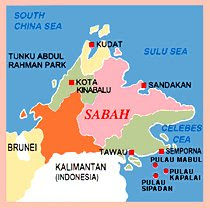1500s-1800s
Sabah or North Borneo was part of the Sultanate of Brunei around the early 16th century. This was during the period when the Sultanate's influence was at its peak. In 1658 the Sultanate of Brunei ceded the north-east portion of Borneo to the Sultan of Sulu in compensation for the latter's help in settling a civil war in the Brunei Sultanate. In 1761 an officer of the British East India Company, Alexander Dalrymple, concluded an agreement with the Sultan of Sulu to allow him to set up a trading post in the region. This together with other attempts to build a settlement and a military station centering around Pulau Balambangan proved to be a failure. There was minimal foreign interest in this region afterward and control over most parts of north Borneo seems to have remained under the Sultanate of Brunei.
In 1865 the American Consul of Brunei, Claude Lee Moses, obtained a 10-year lease over North Borneo from the Sultan of Brunei. Ownership was then passed to an American trading company owned by J.W. Torrey, T.B. Harris and some Chinese merchants. They set up a base and settlement in Kimanis but this too failed due to financial reasons. The rights of the trading company were then sold to Baron Von Overbeck, the Austrian Consul in Hong Kong, and he later obtained another 10-year renewal of the lease. The rights were subsequently transferred to Alfred Dent, whom in 1881 formed the British North Borneo Provisional Association Ltd.
In the following year, the British North Borneo Company was formed and Kudat was made its capital. In 1883 the capital was moved to Sandakan to capitalise on its potential of vast timber resources. In 1888 North Borneo became a protectorate of Great Britain. Administration and control over North Borneo remained in the hands of the Company despite being a protectorate and they effectively ruled until 1942. Their rule had been generally peaceful except for some rebellions, including one led by the Suluk-Bajau leader Mat Salleh from 1894 to 1900,[1] and another led by the Muruts which is known as the Rundum resistance in 1915.[2]
[edit] Second World War and the road to independence
From 1942 to 1945 during the Second World War, Japanese forces occupied North Borneo. The Japanese forces landed in Labuan on January 1, 1942 and continued to invade the rest of North Borneo. Bombings by the allied forces devastated of most towns including Sandakan, which was totally razed to the ground. Resistance against Japanese occupation were concentrated on the west and north coast of North Borneo. The resistance in Jesselton was led by Albert Kwok and Jules Stephens of the Kinabalu Guerillas. Another resistance was led by Panglima Alli from Sulug Island, off the coast of Jesselton. In Kudat, there were also some resistance led by Tun Datu Mustapha. On October 10, 1943, the Kinabalu Guerrilas together with followers of Panglima Alli staged a surprise attack on the Japanese. The attack however was foiled. The 324 local residents who participated in the attacks, including Albert Kwok and Panglima Alli, were detained in Petagas and later executed on January 21, 1944.[3] The site of the execution is today known as the Petagas War Memorial.
When Japan surrendered at the end of the war, North Borneo was administered by the British Military Administration and in 1946 it became a British Crown Colony. Jesselton was chosen to replace Sandakan as the capital. The Crown continued to rule North Borneo until 1963. On August 31, 1963 North Borneo attained self-government. There was a call for complete independence on that date by it was denied by the British Governor whom remained in power until Malaysia Day.[4] The intention had been to form Malaysia on August 31 but due to objection from the Philippines and Indonesia, the formation had to be postponed to September 16.[citation needed] On September 16, 1963, North Borneo together with Malaya, Sarawak and Singapore formed the Federation of Malaysia and from then on, it became known as Sabah and declared independent from British sovereignty.[2][5] To safeguard the interest of North Borneo in the new federation, a 20-point agreement was entered between the federal and the state government.
[edit] Philippine claim
Main article: Sabah dispute
The Sultanate of Sulu was granted the territory as a prize for helping the Sultan of Brunei against his enemies and from then on that part of Borneo is recognized as part of the Sultan of Sulu's sovereignty. In 1878, Baron Von Overbeck, an Austrian partner representing The British North Borneo Co. and his partner British Alfred Dent, leased the territory of Sabah. In return, the company will provide arms to the Sultan to resist the Spaniards and 5,000 Malaysian ringgits annual rental based on the Mexican dollars value at that time or its equivalent in gold. This lease have been continued until the independence and formation of the Malaysian federation in 1963 together with Singapore, Sarawak and Malaysia.
Despite the supply of arms, the Sultanate of Sulu came under the control of Spain. In 1885, Spain relinquished all of its claim to Borneo to the British in the Madrid Protocol of 1885.
While the claim still being exist, the present situation of illegal immigrant from Philippine entering causing much social problem for Sabah will only put the people of Sabah more fearful of this claim. In event this claim brought forward to International Court Of Justice, most people in Sabah will reject and current Malaysia Federal Government has feel the pressure from the people of Sabah.
See also: History of Malaysia and History of Brunei
STACYFRENZ BERPINDAH ALAMAT
15 years ago




No comments:
Post a Comment